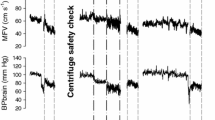Abstract
One proposed method to overcome postflight orthostatic intolerance is for astronauts to undergo inflight centrifugation. Cardiovascular responses were compared between centrifuge and gravitational conditions using a seven-compartment cardiovascular model. Vascular resistance, heart rate, and stroke volume values were adopted from literature, while compartmental volumes and compliances were derived from impedance plethysmography of subjects (n = 8) riding on a centrifuge. Three different models were developed to represent the typical male subject who completed a 10-min postflight stand test (“male finisher”), “non-finishing male” and “female” (all non-finishers). A sensitivity analysis found that both cardiac output and arterial pressure were most sensitive to total blood volume. Simulated stand tests showed that female astronauts were more susceptible to orthostatic intolerance due to lower initial blood pressure and higher pressure threshold for presyncope. Rates of blood volume loss by capillary filtration were found to be equivalent in female and male non-finishers, but four times smaller in male finishers. For equivalent times to presyncope during centrifugation as those during constant gravity, lower G forces at the level of the heart were required. Centrifuge G levels to match other cardiovascular parameters varied depending on the parameter, centrifuge arm length, and the gravity level being matched.




Similar content being viewed by others
References
Blomqvist, C. G., and H. L. Stone. Cardiovascular adjustments to gravitational stress. In: Handbook of Physiology, Sect. 2, The Cardiovascular System, edited by J. T. Shepherd et al. Washington, DC: American Physiological Society, 1982, pp. 1025–1063.
Broskey, J., and M. K. Sharp. Evaluation of mechanisms of postflight orthostatic intolerance with a simple cardiovascular system model. Ann. Biomed. Eng. 35(10):1800–1811, 2007.
Buckey, J. C., L. D. Lane, B. D. Levine, D. E. Watenpaugh, S. J. Wright, W. E. Moore, F. A. Gaffney, and C. G. Blomqvist. Orthostatic intolerance after spaceflight. J. Appl. Physiol. 81(1):7–18, 1996.
Charles, J. B., M. W. Bungo, and G. W. Fortner. Cardiopulmonary function, Chap. 14. In: Space Physiology and Medicine, edited by A. E. Nicogossian, C. L. Huntoon, and S. L. Pool. Philadelphia, PA: Lea & Febiger, 1994.
Charles, J. B., and C. M. Lathers. Cardiovascular adaptation to spaceflight. J. Clin. Pharmacol. 31:1010–1023, 1991.
Evans, J. M. Background: data comes from an experiment on male subjects (n = 8) riding the NASA Ames centrifuge at various arm lengths and resulting Gz levels. Volume shifts of respective body segments were found by tracking segment impedance level against the baseline (supine, non-rotating) level allowing volume to be tracked versus Gz at the heart level. 2009 (unpublished data).
Evans, J. M., F. M. Leonelli, M. G. Ziegler, C. M. McIntosh, A. R. Patwardhan, A. C. Ertl, C. S. Kim, and C. F. Knapp. Epinephrine, vasodilation and hemoconcentration in syncopal, healthy men and women. Autonom. Neurosci. 93:79–90, 2001.
Fritsch-Yelle, J. M., P. A. Whitson, R. L. Bondar, and T. E. Brown. Subnormal norepinephrine release relates to presyncope in astronauts after spaceflight. J. Appl. Physiol. 81(5):2134–2141, 1996.
Gauer, O. N., and H. L. Thron. Postural change in the circulation. In: Handbook of Physiology, Sect. 2, Circulation, Vol. 3, edited by W. F. Hamilton, and P. Dow. Washington, DC: American Physiological Society, 1965, p. 2409.
Gordon, C. C., H. M. Foti, and S. M. Donelson. U.S. Navy/Marine Corps Matched Male and Female Anthropometric Eligible Pilot Databases. Naval Air Warfare Center Aircraft Division: NAWCADPAX—96-221-TM, 1995.
Pantalos, G. M., M. K. Sharp, S. J. Woodruff, S. D. O’Leary, K. J. Gillars, T. Schurfranz, S. D. Everett, M. Lemon, J. Schwartz, and T. E. Bennett. The effect of gravitational acceleration on cardiac diastolic function: a biofluid mechanical perspective with initial results. Curr. Pharm. Biotechnol. 6(4):331–341, 2005.
Perez, S. A., J. B. Charles, W. Fortner, W. Hurst, and J. V. Meck. Cardiovascular effects of anti-G suit and cooling garment during space shuttle re-entry and landing. Aviat. Space Environ. Med. 74(7):753–757, 2003.
Peterson, K., E. T. Ozawa, G. M. Pantalos, and M. K. Sharp. Numerical simulation of the influence of gravity and posture on cardiac performance. Ann. Biomed. Eng. 30(2):247–259, 2002.
Ramsdell, C. G., T. J. Mullen, G. H. Sundby, S. Rostoft, N. Sheynberg, N. Aljuri, M. Maa, R. Mukkamala, D. Sherman, K. Toska, J. Yelle, D. Bloomfield, G. H. Williams, and R. J. Cohen. Midodrine prevents orthostatic intolerance associated with simulated spaceflight. J. Appl. Physiol. 90:2245–2248, 2001.
Smith, J. J. (ed.). Circulatory Response to the Upright Posture. Boca Raton, FL: CRC Press, 1990.
Watenpaugh, D. E., and A. R. Hargens. The cardiovascular system in microgravity, Chap. 29. In: Handbook of Physiology-Environmental Physiology, Sect. 4, Vol. I. Bethesda, MD: American Physiological Society, 1996, pp. 631–674.
Watenpaugh, D. E., D. D. O’Leary, S. M. Schneider, S. M. C. Lee, B. R. Macias, K. Tanaka, R. L. Hughson, and A. R. Hargens. Lower body negative pressure exercise plus brief post exercise lower body negative pressure improve post-bed rest orthostatic tolerance. J. Appl. Physiol. 103:1964–1972, 2007.
Waters, W. W., M. G. Ziegler, and J. V. Meck. Postspaceflight orthostatic hypotension occurs mostly in women and is predicted by low vascular resistance. J. Appl. Physiol. 92:586–594, 2002.
Waters, W. W., S. H. Platts, B. M. Mitchell, P. A. Whitson, and J. V. Meck. Plasma volume restoration with salt tablets and water after bed rest prevents orthostatic hypotension and changes in supine hemodynamic and endocrine variables. Am. J. Physiol. Heart. Circ. Physiol. 288(2):H839–H847, 2005.
White, R. J., and C. G. Blomqvist. Central venous pressure and cardiac function during spaceflight. J. Appl. Physiol. 85(2):738–746, 1998.
Acknowledgment
NASA Grant NNC04GA88G.
Author information
Authors and Affiliations
Corresponding author
Additional information
Associate Editor Jennifer West oversaw the review of this article.
Rights and permissions
About this article
Cite this article
Coats, B.W., Keith Sharp, M. Simulated Stand Tests and Centrifuge Training to Prevent Orthostatic Intolerance on Earth, Moon, and Mars. Ann Biomed Eng 38, 1119–1131 (2010). https://doi.org/10.1007/s10439-010-9943-3
Received:
Accepted:
Published:
Issue Date:
DOI: https://doi.org/10.1007/s10439-010-9943-3




